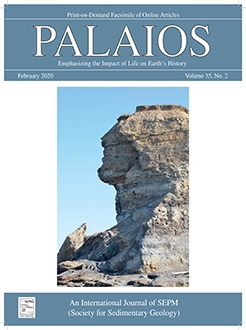The lake bottom along structural platforms in Lake Tanganyika, Africa, is carpeted with numerous large shell beds, known to be of late Holocene age, but of uncertain assemblage process. The shell beds may be the result of sedimentological (physical) assembly processes, or biological processes, or both. Previous work focused on the distribution of shell-rich facies, and showed time averaging of the surficial shell bioclasts over the last ∼ 1600 calendar years BP. We focus on an extensive shell deposit along a deltaic platform in Kungwe Bay, Tanzania and examine time-averaging and taphonomy of Neothauma tanganyicense shells to constrain sedimentological and biological processes forming concentrations of shells. New radiocarbon dating indicates that Neothauma shells are time-averaged over the last ∼ 3000 calendar years. Younger shells predominate shallow-water and exhibit unimodal age distributions, while shells from deeper-water exhibit a broader age distribution. Taphonomic results indicate that water depth and distance from the delta river mouth influence shell abrasion and encrustation with more encrustation developing away from sediment input points. Shells with black coatings and reddish-orange oxidation patinas suggest local burial and exposure. The age-frequency distributions of the shells suggest production rates of the shells vary over time and with water depth, tracking climatically driven lake-level changes (e.g., Little Ice Age, ∼ 100–650 BP). In addition, age-distributions suggest that (1) mixing of different populations are more prevalent along the steeper deltaic slopes, and (2) recent decreasing production rates may reflect anthropogenic land-use change and attendant sedimentation, which has implications for Neothauma itself, and for organisms that are obligate occupants of the shell beds. These results suggest both climatic and depositional processes play unique roles in the distribution and accumulation of shell beds in Lake Tanganyika, which informs interpretation of similar paleoenvironments in the geologic record.
How to translate text using browser tools
10 February 2020
PALEOENVIRONMENTAL IMPLICATIONS OF TIME-AVERAGING AND TAPHONOMIC VARIATION OF SHELL BEDS IN LAKE TANGANYIKA, AFRICA
Emily K. Ryan,
Michael J. Soreghan,
Michael M. McGlue,
Jonathan A. Todd,
Ellinor Michel,
Darrell S. Kaufman,
Ismael Kimirei
ACCESS THE FULL ARTICLE
It is not available for individual sale.
This article is only available to subscribers.
It is not available for individual sale.
It is not available for individual sale.

PALAIOS
Vol. 35 • No. 2
February 2020
Vol. 35 • No. 2
February 2020




